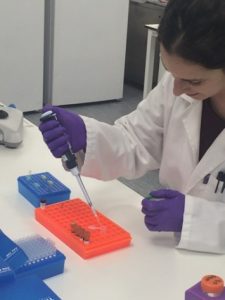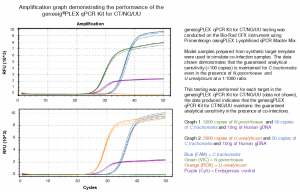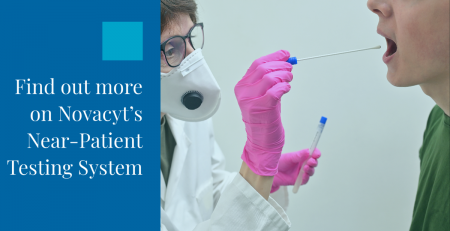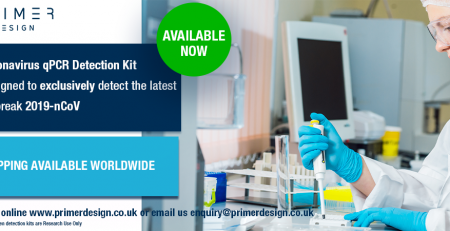Primerdesign is proud to present three brand new real-time PCR product ranges to our portfolio. Firstly, genesigMYPLEX qPCR Kit STD is a personalised approach to multiplex assays. You have full control to select any 2 or 3-way combination of the 10 most prevalent STD pathogens in an easy-to-use multiplex qPCR assay. The 10 most prevalent STD pathogens that can be selected include:
| Chlamydia trachomatis | Neisseria gonnorrhoeae |
| Gardnella vaginalis | Treponema parvum |
| Herpes simplex type 1 and 2 | Trichomonas vaginalis |
| Mycoplasma genitalium | Ureaplasma parvum |
| Mycoplasma hominis | Ureaplasma urealyticum |
Our second new range of products are genesigPLEX qPCR Kits, which are unique multiplex qPCR assays that allow simultaneous detection of multiple, preselected pathogens. The genesigPLEX qPCR Kits are available as multiplex panels for the following infections:
| Target Infection Panel | genesigPLEX qPCR Kit |
| Infections of the immunosuppressed | genesigPLEX qPCR Kit CMV/EBV/BKV |
| Sexually Transmitted Disease | genesigPLEX qPCR Kit CT/NG/UU |
| Respiratory | genesigPLEX qPCR Kit FluA/FluB/RSV |
| Hepatitis | genesigPLEX qPCR Kit HAV/HEV |
| Blood-borne | genesigPLEX qPCR Kit HBV/HCV/HIV1/HIV2 |
| Veterinary – Equine Strangles | genesigPLEX qPCR Kit SE/SZ |
Both new products include our brand new oasigPLEX Lyophilised qPCR Master Mix. These are specialised master mixes optimised for multiplex applications. Included in oasigPLEX Lyophilised qPCR Master Mixes is ampliSOLVE, an innovative solution that will enhance real-time PCR efficiency through artefact removal. The function of ampliSOLVE is to remove amplicon contamination, resulting in an enhanced efficiency and performance of the qPCR reaction.
All these products demonstrate state of the art use of real-time PCR. We interviewed Sara, our Research Assistant, who has worked on the development of these new products.
Sara commented before the interview:
“I feel really honoured to have been part of the development of our new products. Our customers can now benefit from new multiplexed assays to detect several targets in a single tube, which allows them to streamline their experiments by saving samples, time and reagents”.
What is your background and how did you become interested in science?
I grew up in a small town near Valencia in Spain. I remember I used to help my grandmother making her own soap using olive oil. I thought it was fascinating and I wanted to know the chemical processes involved. I was intrigued about knowing how things worked, and through the years I developed an interest in science.
I guess that curious part of my personality was the determining factor to take a degree in Biotechnology at the Technical University of Valencia, Spain. During my degree I learnt that the process my grandmother was following is called saponification! I also came across molecular biology techniques, including qPCR. I became fascinated about the detection of diseases using this powerful technique, so for my master’s dissertation I moved to the UK and worked at Cancer Research UK in Liverpool, studying micro RNAs for the early detection of lung cancer. This was an amazing opportunity for me to learn about qPCR and diagnostics, so after my degree I decided that I would pursue a career designing and optimizing qPCR kits for the detection of not just cancer, but other diseases and pathogens at Primerdesign.
Where did the idea behind these products come from?
We wanted to supply our customers with multiplex solutions for testing closely related panels of pathogens. Multiplex assays have the benefit of allowing simultaneous amplification of multiple targets in a single tube by using specific primers and probes that are labelled with different fluorophores. Using a single tube for the reaction reduces set up times and amount of reagents, subsequently less pipetting steps are required, which reduces the chance of pipetting error.
genesigMYPLEX qPCR Kit STD was developed to provide you with the opportunity to personalise your multiplex assay. The diagnostic market is moving towards multiplex assays and we wanted to make sure you test exactly what you require. With this in mind, we wanted to provide a master mix that was specifically designed and optimised for multiplex formats to help with this. oasigPLEX Lyophilised qPCR Master Mixes are specifically made to target this niche and reduce the increased difficulties that multiplex assays can cause.
What were the development steps you took to make this product?
The first step in the development process was to select the targets of interest by researching different infection panels that could be combined in a multiplex assay. Then our Design Team specially produced primers and probe sequences for each of the selected pathogens, so they could be incorporated into multiplex assays.
Once the primer and probe sequences have been determined, we needed to find the optimum concentration for each the forward and reverse primers. To do this, different concentrations were tested within parameters to produce a bell-shaped curve, which then decided increased focused concentrations to test. While determining the concentration of each primer, it was important to consider that performance of assays had to be maintained when combined in a multiplex format. Additionally, we assessed the ability of the multiplex assay to detect low copy numbers of each target.
All new products, including oasigPLEX Lyophilised qPCR Master Mixes, underwent component analysis and optimisation, as well as evaluating whether other additions would make it more suitable for you.
What was your team’s typical day in the lab during the development of these products?

The typical day would start with concentration optimisation of each primer and probe. We achieved this by testing a range of primer and probe concentrations on serial dilutions of DNA for each target as described in the development steps. After looking at the efficiency of the standard curve data and the sensitivity that each concentration of primer produces, we would then select the best.
Once primer concentrations were established, we tested the multiplex assay’s capability of detecting low copy number of each template in the presence of the process control, which in the case of genesigMYPLEX qPCR Kit STD was hACTB. We guarantee below 100 copy number detection in our genesig qPCR Kits.
Finally, we ran co-infection tests, which the multiplex assay’s functionality is addressed by testing its ability to simultaneously detect multiple DNA targets in one single reaction. In the case of genesigMYPLEX qPCR Kit STD, we tested different combinations of 3-way multiplexes (plus process control) with a sample that mimics a clinical specimen combining two targets with high copy number and one target with low copy numbers. This confirms the performance claims are justified even when using difficult samples.
What were the major challenges you faced during the research and development of these products?
As multiplex reactions have multiple primers in the same tube, the main challenge was to make sure primer interactions were minimized as much as possible. It was very important to avoid this interaction as it would cause primer dimers, resulting in reduced or even no amplification. The primers were also required to be specific to the target of interest and not cross-react with other organism’s sequences. This meant that primers had to be designed correctly.

While developing oasigPLEX Lyophilised qPCR Master Mixes the main problem was working with RNA. RNA assays are notoriously hard to multiplex together due to the significantly high risk of primer dimers being formed due to reverse transcriptase involvement. We evaluated a few improvements, but a clear winner was the addition of ampliSOLVE, which is fantastic at artefact removal. The addition of ampliSOLVE reduces primer dimers and vastly improved data which solved the major challenges faced while developing these range of products.
What problem will these products solve?
The multiplex feature of genesigPLEX and genesigMYPLEX qPCR Kits will save you time, money, reagents and samples by being able to detect multiple pathogens in a single reaction. An additional advantage of genesigMYPLEX qPCR Kit STD is that it includes exactly the target pathogens you want. On occasion when buying a multiplex assay, you can receive a target pathogen within the detection kit that you are not necessarily interested in. Therefore, genesigMYPLEX qPCR Kit STD enables you to select exactly the target pathogens you want in a multiplex assay. This means you will not be wasting your time and money on testing pathogens that you are not interested in.
oasigPLEX Lyophilised qPCR Master Mixes are included with these new products. The master mixes enable reliable, uncompromised detection of different pathogens at a low copy number when in conjunction with a multiplex assay.
How does the product work?
Both genesigPLEX qPCR Kits and genesigMYPLEX qPCR Kit STD detect their specified pathogens as the primers and probe sequences have 100% homology to a broad range of clinically relevant reference sequences based on a comprehensive bioinformatic analysis.
During qPCR amplification, forward and reverse primers hybridise to the target cDNA. Fluorogenic probes are included in the same reaction mixture, which consists of a DNA probe labelled with a 5`-dye and a 3`-quencher. During PCR amplification, the probe is cleaved, and the reporter dye and quencher are separated. The resulting increase in fluorescence can be detected on a range of qPCR platforms. All assays include a positive control to rule out the possibility of a false negative.
oasigPLEX Lyophilised qPCR Master Mixes have all the components for an excellent master mix for either DNA or RNA samples, also supplied lyophilised for ease of use, storage and, stability. The product works through optimised enzyme levels and a proprietary enzyme-buffer system to maximise the performance of the multiplex assay. The qPCR master mixes are designed for rapid cycling protocols and contain an antibody-mediated hot start mechanism which releases more active enzyme and requires a much shorter activation time.
Included within oasigPLEX Lyophilised qPCR Master Mixes is ampliSOLVE, which enhances real-time PCR efficiency through artefact removal. The function of ampliSOLVE is to remove amplicon contamination, resulting in an enhanced efficiency and performance of the qPCR reaction. In RT-qPCR reactions, ampliSOLVE reduces the possibility of primer dimer formation. Resulting in successful multiplex reactions.
Many thanks to Sara for providing answers about these new products. At Primerdesign we thrive to innovate and make new products just like the new genesigPLEX qPCR Kits, genesigMYPLEX qPCR Kit STD and oasigPLEX Lyophilised qPCR Master Mixes. Look out for future new products within this blog and across social media.













